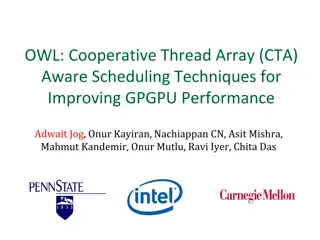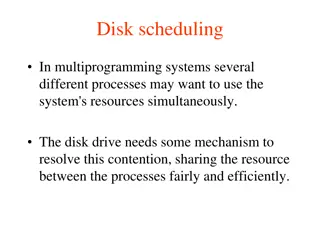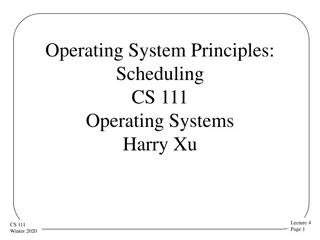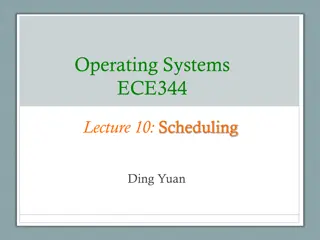Exploring Dynamic Programming Concepts in Job Scheduling
Delve into the world of dynamic programming by examining the application of segmented least squares, knapsack problems, and job scheduling optimization. Discover the challenges of finding optimal solutions and explore different strategies to address complex scheduling scenarios efficiently.
Download Presentation

Please find below an Image/Link to download the presentation.
The content on the website is provided AS IS for your information and personal use only. It may not be sold, licensed, or shared on other websites without obtaining consent from the author. Download presentation by click this link. If you encounter any issues during the download, it is possible that the publisher has removed the file from their server.
E N D
Presentation Transcript
What did we talk about last time? Dynamic programming Segmented least squares
A deck of cards has positive integers on one side and either red or blue on the other side. Consider the following hypothesis: If a card shows an even number on one side, it's red on the other side. Which cards must you turn over to test this hypothesis?
Let's say that we have a series of n jobs that we can run on a single machine Each job i takes time wi We must finish all jobs before time W We want to keep the machine as busy as possible, working on jobs until as close to W as we can
This fundamental problem can be looked at in many ways: Try to fill up a knapsack with objects where each has weight wi and the knapsack can only hold W Take a set of numbers and find a subset whose sum is as close as possible to a target value
No one knows a natural greedy solution for this problem Always take the biggest that fits doesn't work: Consider set {W/2 + 1, W/2, W/2} Always take the smallest that still fits doesn't work: Consider set {1, W/2, W/2}
Like before, we could consider the optimal value OPT(n) of all jobs up to n If n is not in the solution, OPT(n) = OPT(n 1) So far, so good If nis in the solution Crap. We don't get very much information about what other jobs can't be in the solution We need to add more information
We want to think about weights If we have job n in the solution, then there will only be W wn capacity left Let's assume that all the weights are integers Then, we could define a class of optimal values: OPT ?,? = max ??,such that ?? ? ? ? ? ? ? We're going to store optimal values for sets of jobs {1, 2, , i} that do not exceed weight w, for all possible jobs i and weights w
If job n is not in the optimal set, OPT(n, W) = OPT(n 1, W) If job n is in the optimal set, OPT(n, W) = wn + OPT(n 1, W wn) We can make the full recurrence for all possible weight values: If w < wi, then OPT(i, w) = OPT(i 1, w) Otherwise, OPT(i, w) = max(OPT(i 1, w), wi + OPT(i 1, w wi))
Create 2D array M[0n][0W] For w from 1 to W Initialize M[0][w] = 0 For i from 1 to n For w from 0 to W If w < wi, then OPT(i, w) = OPT(i 1, w) Else OPT(i, w) = max(OPT(i 1, w), wi + OPT(i 1, w wi)) Return M[n][W]
We're building a big 2D array Its size is nW n is the number of items W is the maximum weight Actually, it's got one more row and one more column, just to make things easier The book makes this array with row 0 at the bottom I've never seen anyone else do that I'm going to put row 0 at the top
0 0 0 0 0 0 0 0 0 0 0 0 0 1 0 2 0 0 0 0 i 1 0 i 0 0 0 0 n 0 w- wi 0 1 2 w W
The algorithm has a simple nested loop The outer loop runs n + 1 times The inner loop runs W + 1 times The total running time is O(nW) The space needed is also O(nW) Note that this time is not polynomial in terms of n It's polynomial in n and W, but W is the maximum weight Which could be huge! We call running times like this pseudo-polynomial Things are fine if W is similar to n, but it could be huge!
Like the other dynamic programming problems, the hard part is finding the actual value of the optimal solution We can trace back from M[n][W], depending on whether the value was included or not Given a filled in table M, we can find an optimal set of jobs in O(n) time
Weights: 2, 7, 1, 3, 8, 4 Maximum: 19 Create the table to find all of the optimal values that include items 1, 2, , i for every possible weight w up to 19
i wi 0 1 2 3 4 5 6 7 8 9 10 11 12 13 14 15 16 17 18 19 0 0 0 0 0 0 0 0 0 0 0 0 0 0 0 0 0 0 0 0 0 0 1 2 0 2 7 0 3 1 0 4 3 0 5 8 0 6 4 0
The knapsack problem is a classic problem that extends subset sum a little As before, there is a maximum capacity W and each item has a weight wi Each item also has a value vi The goal is to maximize the value of objects collected without exceeding the capacity like Indiana Jones trying to put the most valuable objects from a tomb into his limited-capacity knapsack
The knapsack problem is really the same as subset sum, except that we are concerned with maximum value instead of maximum weight We need only to update the recurrence to keep the maximum value: If w < wi, then OPT(i, w) = OPT(i 1, w) Otherwise, OPT(i, w) = max(OPT(i 1, w), vi + OPT(i 1, w wi))
Items (wi, vi): (7, 9) (3, 4) (2, 3) (6, 2) (4, 5) (5, 7) Maximum weight: 10 Create the table to find all of the optimal values that include items 1, 2, , i for every possible weight w up to 10
i wi vi 0 1 2 3 4 5 6 7 8 9 10 0 0 0 0 0 0 0 0 0 0 0 0 0 0 1 7 9 0 2 3 4 0 3 2 3 0 4 6 2 0 5 4 5 0 6 5 7 0
Work on Homework 5 Read section 6.6























